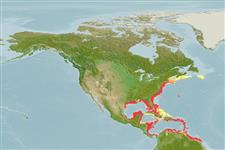>
Syngnathiformes (Pipefishes and seahorses) >
Syngnathidae (Pipefishes and seahorses) > Syngnathinae
Etymology: Hippocampus: Greek, ippos = horse + Greek,kampe = curvature (Ref. 45335).
Environment: milieu / climate zone / пределы глубины / distribution range
экология
морской ассоциированный с рифами; немигрирующий; пределы глубины 0 - 100 m (Ref. 128812). Subtropical; 10°C - 27°C (Ref. 36630); 50°N - 32°S, 98°W - 32°W (Ref. 52034)
Western Atlantic: Canada (off Scotian shelf) to Brazil; including countries of the Gulf of Mexico and the West Indies. A southern form that may prove to be a separate species is known from Rio de Janeiro, Brazil and questionably from Suriname.
Length at first maturity / Size / Вес / Возраст
половая зрелость: Lm 6.3 range ? - ? cm
Max length : 19.0 cm OT самец/пол неопределен; (Ref. 30915); наибольший возраст (опубликованны данные): 1.00 годы (Ref. 1285)
колючие лучи спинного плавника (общее число) : 0; членистые (мягкие) лучи спинного плавника (общее число) : 16 - 20.
Body shape (shape guide): other.
Generally in coastal waters; often around man-made structures (Ref. 26938). Usually attached to gorgonians or seagrasses but may occur in floating Sargassum or swimming freely in midwater (Ref. 9710). Those that live in Sargassum usually have bony protuberances and fleshy tabs that may serve as camouflage. Has been reared in captivity (Ref. 35420, 35422). Move into deeper waters during winter (Ref. 36630). Feeds by sucking in small organisms, using its long face as a pipette (Ref. 26938); like small crustaceans (Ref. 27549). Ovoviviparous (Ref. 205). The male carries the eggs in a brood pouch which is found under the tail (Ref. 205). Length type refers to Height (= from top of coronet to the tip of straightened tail).
Incubates eggs in an external marsupium. Gestation period 20-21 days but varies with water temperature (Ref. 30915).
Lourie, S.A., R.A. Pollom and S.J. Foster, 2016. A global revision of the seahorses Hippocampus Rafinesque 1810 (Actinopterygii: Syngnathiformes): taxonomy and biogeography with recommendations for further research. Zootaxa 4146(1):1-66. (Ref. 115213)
Статус Красного Списка МСОП (Ref. 130435: Version 2024-2)
Угроза для людей
Harmless
Использование человеком
рыболовство: не имеет хозяйственного значения; аквариум: коммерческий
дополнительная информация
инструменты
Специальные отчеты
Скачать в формате XML
ресурсы в Интернет
Estimates based on models
Preferred temperature (ссылка
123201): 12.1 - 27, mean 24 °C (based on 144 cells).
Phylogenetic diversity index (ссылка
82804): PD
50 = 0.5000 [Uniqueness, from 0.5 = low to 2.0 = high].
Bayesian length-weight: a=0.00447 (0.00175 - 0.01142), b=2.99 (2.77 - 3.21), in cm total length, based on LWR estimates for this (Sub)family-body shape (Ref.
93245).
Trophic level (ссылка
69278): 3.5 ±0.51 se; based on food items.
Generation time: 3.2 ( na - na) years. Estimated as median ln(3)/K based on 1
growth studies.
устойчивость к внешним воздействиям (ссылка
120179): высокий, минимальное время удвоения популяции до 15 месяцев (K=0.34; tmax=1; Fec=1,552).
Fishing Vulnerability (Ref.
59153): Low to moderate vulnerability (31 of 100).
🛈
Nutrients (Ref.
124155): Calcium = 47.1 [22.2, 120.5] mg/100g; Iron = 0.62 [0.33, 1.15] mg/100g; Protein = 18.5 [17.4, 19.7] %; Omega3 = 0.186 [0.102, 0.333] g/100g; Selenium = 15.1 [6.8, 35.8] μg/100g; VitaminA = 78.1 [23.5, 255.2] μg/100g; Zinc = 0.985 [0.614, 1.530] mg/100g (wet weight);
